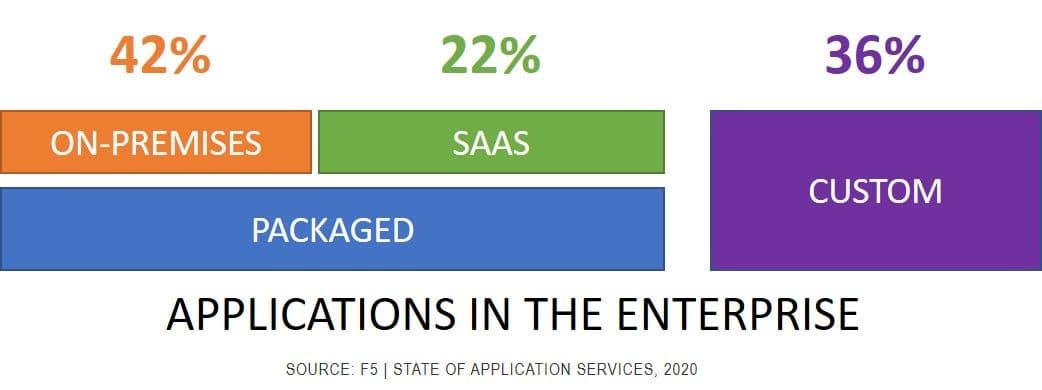If you're packing up your on-premises software and moving to SaaS, you're not alone.
Since the early days of cloud, the bulk of adoption has been (and remains, for that matter) in SaaS. The same software that was once commoditized and packaged up to be sold to enterprises is now being offered as a service via the cloud. This is not new or different. Old timers like me remember well the days of the ASP (Application Service Provider) before it was abruptly recast as cloud because, well, cloud was cooler. And by cooler, I mean hotter.
But while SaaS is not really all that new, what is new is the range of activities being commoditized and packaged as SaaS. All manner of business functions are joining CRM, SFA, productivity, and communications as SaaS offerings.

And we anticipate that organizations will quickly jump at the chance to offload the operation of such software to a provider.
We aren't alone.
Respondents to IDG's 2020 Cloud Computing survey also "expect in the next 18 months to reduce their use of commercially licensed software (65% currently, down to 50%) in favor of software as a service (SaaS) applications (up from 24% to 36%)."
The big winners are business continuity-related IT services such as backup, recovery, storage, and archive. Unsurprisingly this category is joined by commoditized business functions like CRM, ERP, HR, and other line of business applications. Typically, the applications moving to SaaS are those that do not offer high value returns when customized. A standard operating procedure/process serves the business well enough that resources are better invested in other areas where customization of process will yield higher value results.
This is especially true when the SaaS supports an ecosystem that makes integration a non-issue. A significant amount of development effort goes into integration, which is essentially the technical implementation of stitching together a process. Or, in modern terms, a digital workflow. When SaaS providers do the hard work and enable checkbox integration to establish that workflow, it wins.
The Return of IT as a Service
Another less often mentioned area of SaaS adoption is in the IT infrastructure space. Not the infrastructure itself, but much of the day two and beyond operational aspects of infrastructure like provisioning, configuring, operating, and reporting on application services. As significant percentages of IT professionals continue to work from home, access to data center (and cloud-based) infrastructure has become a critical capability they need to do their jobs. Traditional models that isolate management networks from external access can hinder these capabilities. A more modern, SaaS-based approach maintains the access control and protection required to safeguard these critical functions while enabling IT professionals to operate infrastructure from anywhere.
Too, the workflows are generally not highly differentiated and thus provide little competitive or business advantage. The process of deploying the on average ten application services required to deliver and secure an application is standardized from an application service perspective. While the application services themselves provide differentiated capabilities, the management processes generally do not. They meet the basic requirements for moving to a SaaS-based model.
This isn't a new concept. I talked about this ten years ago in the context of the Infrastructure 2.0 movement (scroll down to the architectural parfait discussion). While many aspects of technology have changed since then, the need to layer operational capabilities across cloud and data centers has not. In fact, the de facto multi-cloud operational model coupled with a new urgency for remote work capabilities has only exacerbated the need for SaaS-based management models that support data center- and cloud-deployed infrastructure with equal alacrity.
Expect to see increased delivery of traditional infrastructure management capabilities via a SaaS model in the coming years as we settle into the new normal of multi-cloud and work from anywhere.
About the Author

Related Blog Posts

Multicloud chaos ends at the Equinix Edge with F5 Distributed Cloud CE
Simplify multicloud security with Equinix and F5 Distributed Cloud CE. Centralize your perimeter, reduce costs, and enhance performance with edge-driven WAAP.
At the Intersection of Operational Data and Generative AI
Help your organization understand the impact of generative AI (GenAI) on its operational data practices, and learn how to better align GenAI technology adoption timelines with existing budgets, practices, and cultures.
Using AI for IT Automation Security
Learn how artificial intelligence and machine learning aid in mitigating cybersecurity threats to your IT automation processes.
Most Exciting Tech Trend in 2022: IT/OT Convergence
The line between operation and digital systems continues to blur as homes and businesses increase their reliance on connected devices, accelerating the convergence of IT and OT. While this trend of integration brings excitement, it also presents its own challenges and concerns to be considered.
Adaptive Applications are Data-Driven
There's a big difference between knowing something's wrong and knowing what to do about it. Only after monitoring the right elements can we discern the health of a user experience, deriving from the analysis of those measurements the relationships and patterns that can be inferred. Ultimately, the automation that will give rise to truly adaptive applications is based on measurements and our understanding of them.
Inserting App Services into Shifting App Architectures
Application architectures have evolved several times since the early days of computing, and it is no longer optimal to rely solely on a single, known data path to insert application services. Furthermore, because many of the emerging data paths are not as suitable for a proxy-based platform, we must look to the other potential points of insertion possible to scale and secure modern applications.
